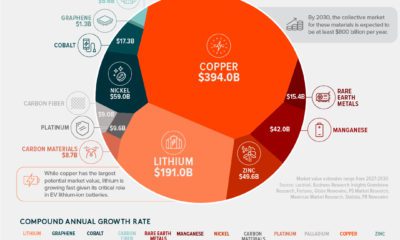There is real money and real management behind every company—but surprisingly, not every company has a concrete strategy to build a business and create value for shareholders.
Business Plan, or Lack Thereof?
Today’s infographic comes to us from Eclipse Gold Mining and it shows you how to avoid common mistakes when evaluating and investing in mining exploration stocks. Specifically, we look at five ways that potential investors can detect the presence and viability of a mining company’s business plan.
Visit Part 1 of “Common Mistakes With Mining Stocks” on Team by clicking here So, what should investors be looking for, when it comes to examining the business plan of a mining exploration company?
#1: Clear Vision vs. All Hope & Dreams
A company should articulate a clear vision rather just simply following the trends and hoping for the best. A long term vision for a business plan is critical as it will be guiding and reminding stakeholders of the company’s purpose through the thick and thin. Signs of a Clear Vision:
The company is actively reaching out to investors Projects can be profitable at today’s commodity prices Provide detailed timelines of work Funds committed to work
A clear vision in business will give the company a direction to aim for, allowing everyone to work quickly towards objectives.
#2: Sense of Urgency vs. Wait & See
Time is money, especially in mining. Companies need to build value fast to finance at higher share prices so that early shareholders do not get diluted. A company needs to make concrete decisions that drive towards value creation. Signs of a Sense of Urgency:
“Time is now” mentality Decisive actions Sense of purpose Solution-oriented thinking
It is expensive to maintain a company, especially one that does not yet produce income. Expenses add up quickly and that is why management needs to make sure they focus their efforts and money on activities that generate value for shareholders.
#3: Laser Focus vs. Spray & Pray
The mineral exploration business is tough and each project requires the undivided attention of managers. Smart companies maintain incredible focus to de-risk their projects while others spread themselves thin with multiple projects.
Signs of a Laser Focus: Properties with a focused vision towards production Specialized management experience aligned with the project Aligning management skill sets with each phase of a project
In order to assess whether a company has the right focus you have to see whether the company is aligning its human assets with its physical assets and a goal in mind.
This focus will help to clarify the story for investors.
#4: Tell the Story vs. Hiding Behind the Science
Communication and business acumen are the key to take a project to market. Mining requires massive amounts of geological knowledge, but that is not the investor’s job to handle. They do not want to want to know the subtleties of geochemistry—they just want to know whether they can make money from those rocks. Companies that hide behind a wall of geological slides may not have not a real story to tell, and they may be pulling investors into funding their own science projects. At the same time, investors need to make sure that the data being presented matches the story being told. Signs of Telling the Story:
Aware of risks, and communicating those risks Clear understanding of local geology Data from drill results back up the story Consistent message
If a company cannot communicate effectively, how are they going to deal with other, more complicated aspects of a mining business plan?
#5: Endgame in Mind vs. Kicking the Can Down the Road
A journey begins with a single step, but without a business plan and commitment, there will never be an end in sight. Quality companies foresee how their project will come together to generate both liquidity and an exit plan for shareholders. There are several clues investors can use to tell if a company is moving towards its goals. Signs of the Endgame in Mind:
List of accomplished goals Clear vision of future goals and exit strategy Plan for liquidity events for shareholder
The goal in investing is to make money. If shareholders are not making money, what is the point? If a company has no plan, it has no hope.
Making the Right Decisions
Understanding the characters that create value for mining companies is the first step, and the second step is assessing whether there is a viable business plan at hand. While the risks are high, an effective plan is the first step towards reducing risks and providing shareholders with value. on Last year, stock and bond returns tumbled after the Federal Reserve hiked interest rates at the fastest speed in 40 years. It was the first time in decades that both asset classes posted negative annual investment returns in tandem. Over four decades, this has happened 2.4% of the time across any 12-month rolling period. To look at how various stock and bond asset allocations have performed over history—and their broader correlations—the above graphic charts their best, worst, and average returns, using data from Vanguard.
How Has Asset Allocation Impacted Returns?
Based on data between 1926 and 2019, the table below looks at the spectrum of market returns of different asset allocations:
We can see that a portfolio made entirely of stocks returned 10.3% on average, the highest across all asset allocations. Of course, this came with wider return variance, hitting an annual low of -43% and a high of 54%.
A traditional 60/40 portfolio—which has lost its luster in recent years as low interest rates have led to lower bond returns—saw an average historical return of 8.8%. As interest rates have climbed in recent years, this may widen its appeal once again as bond returns may rise.
Meanwhile, a 100% bond portfolio averaged 5.3% in annual returns over the period. Bonds typically serve as a hedge against portfolio losses thanks to their typically negative historical correlation to stocks.
A Closer Look at Historical Correlations
To understand how 2022 was an outlier in terms of asset correlations we can look at the graphic below:
The last time stocks and bonds moved together in a negative direction was in 1969. At the time, inflation was accelerating and the Fed was hiking interest rates to cool rising costs. In fact, historically, when inflation surges, stocks and bonds have often moved in similar directions. Underscoring this divergence is real interest rate volatility. When real interest rates are a driving force in the market, as we have seen in the last year, it hurts both stock and bond returns. This is because higher interest rates can reduce the future cash flows of these investments. Adding another layer is the level of risk appetite among investors. When the economic outlook is uncertain and interest rate volatility is high, investors are more likely to take risk off their portfolios and demand higher returns for taking on higher risk. This can push down equity and bond prices. On the other hand, if the economic outlook is positive, investors may be willing to take on more risk, in turn potentially boosting equity prices.
Current Investment Returns in Context
Today, financial markets are seeing sharp swings as the ripple effects of higher interest rates are sinking in. For investors, historical data provides insight on long-term asset allocation trends. Over the last century, cycles of high interest rates have come and gone. Both equity and bond investment returns have been resilient for investors who stay the course.














